| Batalionul 1 anti-terorist al Jandarmeriei - Jandarmery Anti-Terrorist Battalion - |
|||||||||
|
US Equivalent: FBI's HRT |
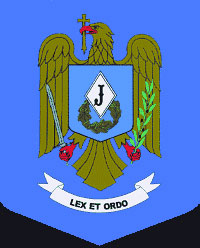
|
||||||||
The special intervention battalion of the Vlad Tepes Special Brigade is composed of members recruited from the two special battalions incorporated in the Brigade, as well as outsiders which passed the selection course. Among the outsiders, it is rumoured that personnel coming from disbanded units inside the armed forces, most notably the Para battalions, have found a new career in this unit.
Trained by a very capable and professional colonel, the battalion was in fact created for counter-terrorist operations. The Romanian Constitution states that the Jandarmery ensures the protection of infrastructure objectives with regards to national security. In plain words, that means road and railway passages in mountaineous areas, oil and gas pipelines, refineries, dams and other such objectives are to be protected by the Jandarmery.
In the post 9/11 world, the chances for any of those areas to be targetted is higher than ever before. Add Romania's contribution to the war against terror, and unfortunately, an attack or sabotage is more likely to happen than one would admit.
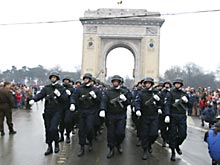
Romania's National Day Parade
Photo by Petrica Mihalache
Although the Jandarmery does not have experience in the domain of counterterrorism, the assignment of the respective colonel to command the unit, as well as an implementation of CT standards were an attempt to create a true CT unit.
No clear data exists as of now, regarding the admission standards of this unit. Since the unit was mainly created for CT purpose, the admission process should similar with the ones of other CT units.
The Special Intervention battalion apparently uses the famous Baneasa live fire training area, in Northern Bucharest. That facility was one of the main training facilities of the ex-Securitate aparatus, which trained its USLA fighters there. After the 1989 Revolution, the facility was transfered under Jandarmery authority.
Since such an important facility can not serve a single unit, it is known that Brigada Antiterorista and FIAT also train there on a regular basis.
Training comprises of a daily schedule which lasts between 6 and 8 hours, and includes physical exercises, live fire exercises, as well as typical CT training.
Also, CQB tactics and other specific methods make up for a significant part of the training.
Members of the Special Intervention battalion employ the Beretta 9mm submachinegun for CT operations. It has also been noticed that the AK-74S 5.45mm submachinegun is also employed during operations which regard the oil pipelines.
The Glock 17 is also widely used, in similarity with almost all other RoSOF units.
The exact order of battle of the Special Intervention battalion is unknown. However, as recent as 2005 and 2006, Ministerial orders have been signed for the creation of local counter-terrorist detachments in some of Romania's largest cities. For example, an order was signed in late 2005 for the creation of a 30 to 40 men CT detachment in Constanta, Romania's second largest city and the country's largest sea port. It is unclear if these few detachments are incorporated in the battalion, if if they represent stand-alone subunits.
In the new 2005 Jandarmery Order of Battle law, it is stipulated that the Romanian Jandarmery is composed of a Mobile Brigade, a Special Brigade, 6 special subunits, plus management, training, medical and logistics facilities and departments. As such, the few CT subunits recently created may be incorporated into the Special Intervention battalion, or they could indeed by among those 6 special operations subunits.
Despite its name as a battalion, the real size of the unit is obviously classified. However, judging by comparison with other CT units in the country, it seems unlikely that the unit literally has 400 to 600 combatants. Also, comparing with units like the military's DIR and the top unit of the MAI, called GSPI Acvila, the battalion does not seem to represent a first choise option for the government in case of a significant attack.
This is not meant to undermine or disconsider any capabilities developed by its members, nor to cast a shadow upon this unit. Still, one has to admit that besides the fact there are at least two other units except GSPI which might be considered as somewhat more suitable for CT intervention, GSPI itself is also a unit of the MAI, and unlike this battalion, that unit is directly under the command of the Minister himself. Furthermore, the most experienced members in the battalion have already applied and successfully joined GSPI in recent years.
The unit participates in exercises with other national, as well as international partners, on a regular basis. A protocole has been signed in april 2006 regarding a close cooperation with the French Gendarmerie for an unlimited period of time.
Operations abroad
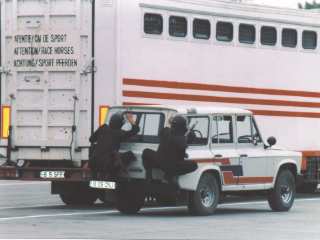 The Special Intervention Battalion performs special police operations, both nationwide as well as abroad (most notably in Kosovo), and has been called to ensure protection during arrests of organized crime elements or other sensitive operations.
The Special Intervention Battalion performs special police operations, both nationwide as well as abroad (most notably in Kosovo), and has been called to ensure protection during arrests of organized crime elements or other sensitive operations.
The Romanian Jandarmery is responsible with anti-terrorist protection of the country's strategic areas. As the top unit of the Jandarmery, members of the special intervention battalion are used to guard Romania's mountain passages, dams, vital railroad links, as well as oil pipelines, gas pipelines, refineries and indeed, the Cernavoda nuclear powerplant itself.
The Romanian Jandarmery has a few hundreds of employees performing missions abroad at any one time. In the past 5 years or so, that number ranged between 200 and 300. One of the areas in which they are present is Kosovo, although we should also mention Bosnia-Herzegovina, Albania, Macedonia, Iraq, and some African countries.
No single unit or detachment has been designated for operations abroad; the usual procedure is to advertise among members that there's a need for, let's say, 115 men for Kosovo, to perform AT protection, special police and CIMIC operations. A certain number of Jandarms will then apply, from all the structures, and those who get selected then attend a 6-month course to prepare them as a team for the upcoming missions.
Active members of the Special Intervention Battalion have thus participated in a wide range of operations abroad, in several countries, without having the unit as a whole to do so.
Counter-terrorism
After September 11th, 2001, there is a significant and increased terrorist threat for all the countries which participate on the war against terror, and indeed, towards all NATO members.
Although al-Qaeda members have been spotted roaming around the country after September 11, 2001, their actions until 2005 have been to determine the strength and weaknesses of the Romanian defense system and send reports back to their command structure. In every ocassion, they did not stay long on Romanian soil, and in about a third of the incidents, they were expelled from the country before they were able to gather any significant information.
In 2005 however, an entire al-Qaeda cell came to Romania with a specific mission. Encouraged by the success of the Madrid 2004 attacks, al-Qaeda has become eager to strike subways all across Europe. In the Madrid attacks, more than 10 percent of the casualties were Romanians, as their wagon was specifically targeted by the bombers, in retaliation of the country's contribution on the war against terror. That fact has however only been mentioned by the Spanish and the Romanian media, as the international press and television, as always, have completely ignored those facts.
The cell's mission was to assess the protection level, the strengths and weaknesses of the Bucharest subway system, in advance of a full scale attack similar to the one in Madrid, a year earlier.
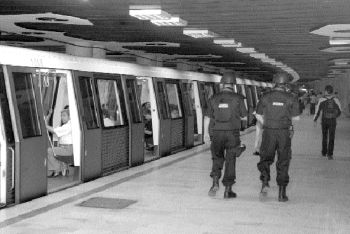 Several members of the al-Qaeda cell have travelled intensively using the subway system. The peak of their operation came when one of them traveled for several hours to all the stations, having a small backpack on him, which was full with objects. His objective was to see if he gets stopped by any law enforcement officials or not. He was under surveillance, but he was led to believe that he wasn't spotted, so no nobody stopped him. Exhilarated by his "success", the operative finally wanted to step out of the subway and head back to his hotel, moment when he was arrested and the next day he was already expelled.
Several members of the al-Qaeda cell have travelled intensively using the subway system. The peak of their operation came when one of them traveled for several hours to all the stations, having a small backpack on him, which was full with objects. His objective was to see if he gets stopped by any law enforcement officials or not. He was under surveillance, but he was led to believe that he wasn't spotted, so no nobody stopped him. Exhilarated by his "success", the operative finally wanted to step out of the subway and head back to his hotel, moment when he was arrested and the next day he was already expelled.
Following that apparent insignificant, but in reality specific threat, the authorities have decided that for the time being, the subway should be patrolled by counter-terrorist operatives. They worked in three schedules, roughly 2 performed by the Special Intervention battalion and 1 by the Brigada Antiterorista.
In the photo above we can see two members of the Special battalion, patrolling the Bucharest subway.
Photo by Ziua newspaper, july 2005.
Oil pipelines
The battalion was called to fight organized crime elements which were subtracting oil and gasolene from the PETROM, ROMPETROL and PETRO-TRANS pipelines. These three companies are very important for the Romanian economy, as only the first one of them, PETROM, gives no less than 20 percent of Romania's total GDP output! Obviously action against this company means a threat to the national security. In such a case, even the Anti-Terrorism Brigade of the Intelligence service can be called, according to the Constitution.
The robbers are very well organized. It is rumoured that those groups bribe employees of the companies or even low-ranking Police agents to turn a blind eye while on watch. It is also rumoured that they have maps of the teritorries crossed by pipelines, since no random digging was ever found at the site. All holes ever digged by the criminal groups were dead accurate on top of the pipelines.
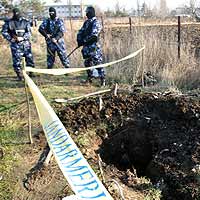 Not a few times, the robbers and the Jandarms have met each other in the pitch dark of the night. Amazingly for a country like Romania, the robbers had firearms and opened fire first towards the Jandarms. Several incidents have occured, especially during 2004, but were not preceded by usage of firearms from the robbers' side, nor did such events continued afterwards. A significant percentage of the underworld elements associated with this "trade" are of a certain ethnic minority, much publicised in the international press. Although they do not represent the planning side of the group, they are employed by their associates to divert the Jandarms' attention from the real digging sites. Due to their ethnicity, they are seldom arrested and are usually let go by law enforcement agents. In cases when they attack the Jandarms using knives or even axes, they do indeed get arrested. However, in such times, international organizations such as APADOR-CH, Human Rights Watch (HRW) or Amnesty International intervene for their defense. It is usually claimed that a discrimination against an ethnic minority took place, which results in bad press at an international level.
Not a few times, the robbers and the Jandarms have met each other in the pitch dark of the night. Amazingly for a country like Romania, the robbers had firearms and opened fire first towards the Jandarms. Several incidents have occured, especially during 2004, but were not preceded by usage of firearms from the robbers' side, nor did such events continued afterwards. A significant percentage of the underworld elements associated with this "trade" are of a certain ethnic minority, much publicised in the international press. Although they do not represent the planning side of the group, they are employed by their associates to divert the Jandarms' attention from the real digging sites. Due to their ethnicity, they are seldom arrested and are usually let go by law enforcement agents. In cases when they attack the Jandarms using knives or even axes, they do indeed get arrested. However, in such times, international organizations such as APADOR-CH, Human Rights Watch (HRW) or Amnesty International intervene for their defense. It is usually claimed that a discrimination against an ethnic minority took place, which results in bad press at an international level.
The creation of this unit was not without controversy. The name "battalion" may or may not imply a unit with 400 to 600 operatives, and the chances are that the actual size of the unit is smaller than that. No one denies that this unit has plenty of operations to perform; however, after the creation of GSPI Acvila in 2003, perhaps time has come that this battalion be disbanded, and the best of its members transferred to the unit mentioned earlier.
Sorin Romanian Special Forces Web Site is Copyright © 2003-2006 by Sorin A. Crasmarelu |